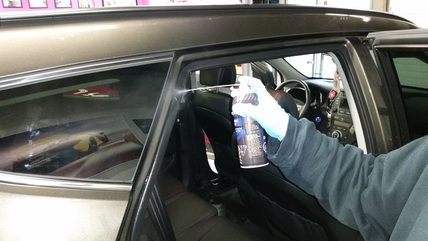We've gone through our first couple of frosty mornings so far this fall, along with a couple of flurries as well. As the days continue to become increasingly cooler, winter vehicle preparation should be considered.
In this week's post, we'll explore the application of silicone spray to your vehicle's door trims.
In this week's post, we'll explore the application of silicone spray to your vehicle's door trims.
Parking your vehicle outdoors in the winter can become a chore. Aside from warming up your vehicle & de-icing it, sticky doors tend to present problems as well. Typically, condensation builds in the rubber door trims, as a result of the freeze-thaw cycle from both the elements and warm to cold vehicle operation.
The above picture illustrates the application of silicone spray to a vehicle's door trims. This application provides a lubricated barrier between the rubber on your door trims and condensation/frost. Once applied, the silicone can last up to the length of a typical winter, but may have to be re-applied depending on foot traffic in-out of vehicle.
Application typically takes no more than five minutes to complete. Purchasing a can of aerosol silicone spray can be made at most big box stores in their automotive section.
Next week, we'll look at the application of windshield repellent to enhance driving visibility.
The above picture illustrates the application of silicone spray to a vehicle's door trims. This application provides a lubricated barrier between the rubber on your door trims and condensation/frost. Once applied, the silicone can last up to the length of a typical winter, but may have to be re-applied depending on foot traffic in-out of vehicle.
Application typically takes no more than five minutes to complete. Purchasing a can of aerosol silicone spray can be made at most big box stores in their automotive section.
Next week, we'll look at the application of windshield repellent to enhance driving visibility.


 RSS Feed
RSS Feed
